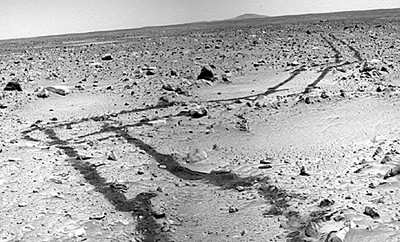Unprecedented Sixth Anniversary Nears
 NASA's Mars rover Spirit will mark
six years of unprecedented science exploration and inspiration for
the American public on Sunday. However, the upcoming Martian winter
could end the roving career of the beloved, scrappy robot. Spirit
successfully landed on the Red Planet at 8:35 p.m. PST on Jan. 3,
2004, and its twin Opportunity arrived at 9:05 p.m. Jan. 24, 2004.
The rovers began missions intended to last for three months but
which have lasted six Earth years, or 3.2 Mars years. During this
time, Spirit has found evidence of a steamy and violent environment
on ancient Mars that was quite different from the wet and acidic
past documented by Opportunity, which has been operating
successfully as it explores halfway around the planet.
NASA's Mars rover Spirit will mark
six years of unprecedented science exploration and inspiration for
the American public on Sunday. However, the upcoming Martian winter
could end the roving career of the beloved, scrappy robot. Spirit
successfully landed on the Red Planet at 8:35 p.m. PST on Jan. 3,
2004, and its twin Opportunity arrived at 9:05 p.m. Jan. 24, 2004.
The rovers began missions intended to last for three months but
which have lasted six Earth years, or 3.2 Mars years. During this
time, Spirit has found evidence of a steamy and violent environment
on ancient Mars that was quite different from the wet and acidic
past documented by Opportunity, which has been operating
successfully as it explores halfway around the planet.
A sand trap and balky wheels are challenges to Spirit's mobility
that could prevent NASA's rover team from using a key survival
strategy for the rover. The team may not be able to position the
robot's solar panels to tilt toward the sun to collect power for
heat to survive the severe Martian winter.
Nine months ago, Spirit's wheels broke through a crusty surface
layer into loose sand hidden underneath. Efforts to escape this
sand trap barely have budged the rover. The rover's inability to
use all six wheels for driving has worsened the predicament.
Spirit's right-front wheel quit working in 2006, and its right-rear
wheel stalled a month ago. Surprisingly, the right-front wheel
resumed working, though intermittently. Drives with four or five
operating wheels have produced little progress toward escaping the
sand trap. The latest attempts resulted in the rover sinking deeper
in the soil.

"The highest priority for this mission right now is to stay
mobile, if that's possible," said Steve Squyres of Cornell
University in Ithaca, N.Y. He is principal investigator for the
rovers.

If mobility is not possible, the next priority is to improve the
rover's tilt, while Spirit is able to generate enough electricity
to turn its wheels. Spirit is in the southern hemisphere of Mars,
where it is autumn, and the amount of daily sunshine available for
the solar-powered rover is declining. This could result in ceasing
extraction activities as early as January, depending on the amount
of remaining power. Spirit's tilt, nearly five degrees toward the
south, is unfavorable because the winter sun crosses low in the
northern sky.

Unless the tilt can be improved or luck with winds affects the
gradual buildup of dust on the solar panels, the amount of sunshine
available will continue to decline until May 2010. During May, or
perhaps earlier, Spirit may not have enough power to remain in
operation.
"At the current rate of dust accumulation, solar arrays at zero
tilt would provide barely enough energy to run the survival heaters
through the Mars winter solstice," said Jennifer Herman, a rover
power engineer at NASA's Jet Propulsion Laboratory in Pasadena,
Calif.

The team is evaluating strategies for improving the tilt even if
Spirit cannot escape the sand trap, such as trying to dig in deeper
with the wheels on the north side. In February, NASA will assess
Mars missions, including Spirit, for their potential science versus
costs to determine how to distribute limited resources. Meanwhile,
the team is planning additional research about what a stationary
Spirit could accomplish as power wanes.
"Spirit could continue significant research right where it is,"
said Ray Arvidson of Washington University in St. Louis, deputy
principal investigator for the rovers. "We can study the interior
of Mars, monitor the weather and continue examining the interesting
deposits uncovered by Spirit's wheels."

A study of the planet's interior would use radio transmissions
to measure wobble of the planet's axis of rotation, which is not
feasible with a mobile rover. That experiment and others might
provide more and different findings from a mission that has already
far exceeded expectations.
"Long-term change in the spin direction could tell us about the
diameter and density of the planet's core," said William Folkner of
JPL. He has been developing plans for conducting this experiment
with a future, stationary Mars lander. "Short-period changes could
tell us whether the core is liquid or solid," he said.

In 2004, Opportunity discovered the first mineralogical evidence
that Mars had liquid water. The rover recently finished a two-year
investigation of a half-mile wide crater called Victoria and now is
headed toward Endeavor crater, which is approximately seven miles
from Victoria and nearly 14 miles across. Since landing,
Opportunity has driven more than 11 miles and returned more than
132,000 images.
 ANN's Daily Aero-Term (12.08.25): Decision Altitude (DA)
ANN's Daily Aero-Term (12.08.25): Decision Altitude (DA) ANN's Daily Aero-Linx (12.08.25)
ANN's Daily Aero-Linx (12.08.25) NTSB Final Report: Piper PA-31T3
NTSB Final Report: Piper PA-31T3 Aero-News: Quote of the Day (12.08.25)
Aero-News: Quote of the Day (12.08.25) Airborne-Flight Training 12.04.25: Ldg Fee Danger, Av Mental Health, PC-7 MKX
Airborne-Flight Training 12.04.25: Ldg Fee Danger, Av Mental Health, PC-7 MKX









